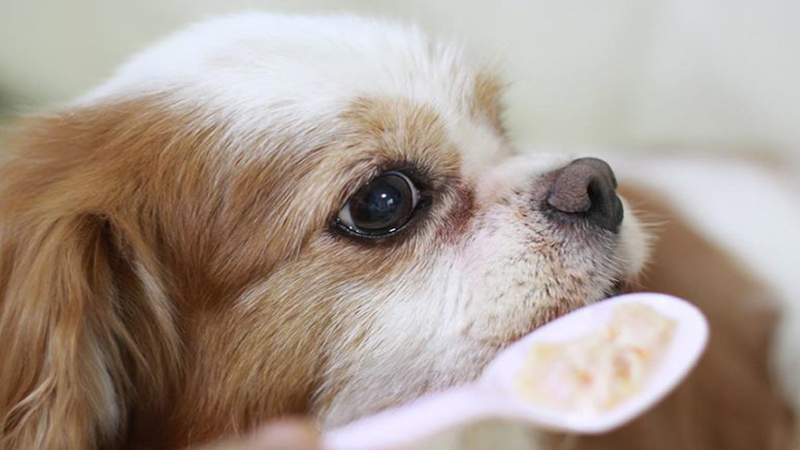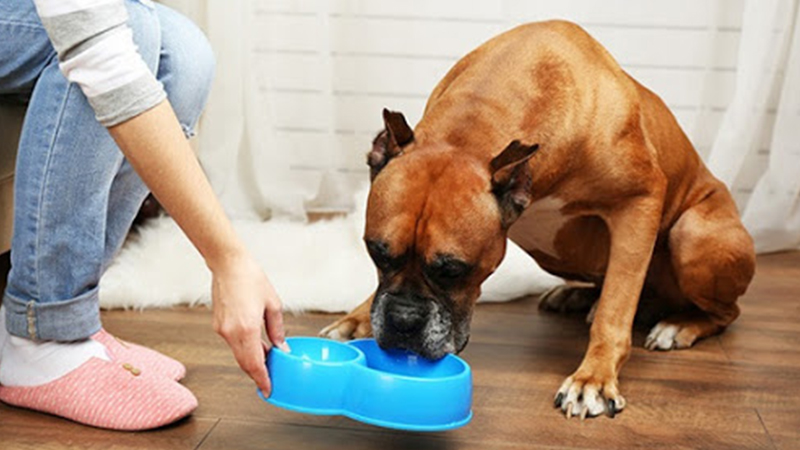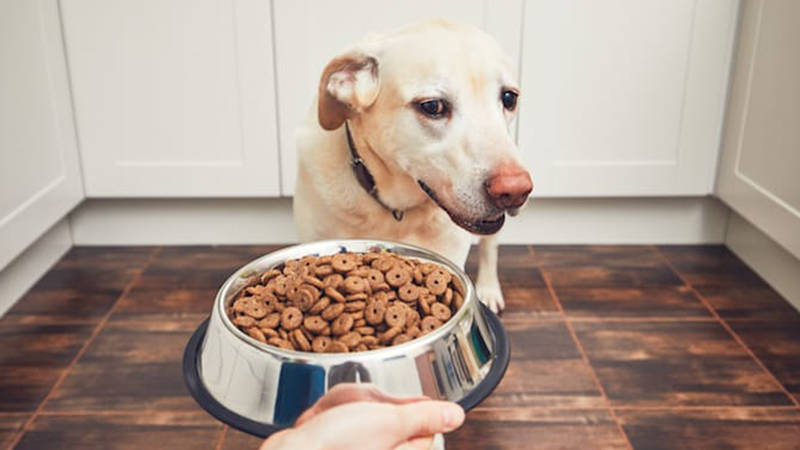The following knowledge will help you understand your pet’s health condition and take appropriate action.
1 How to Treat Diarrhea in Dogs
Using Indigo (Mulberry)
 Treat diarrhea in dogs with indigo plant
Treat diarrhea in dogs with indigo plant
The indigo plant, also known as mulberry, has many medicinal properties for both humans and dogs. Therefore, we can use this plant to treat our canine friends.
Discard the roots of the indigo plant and keep the leaves and stems. Then, we need to grind the leaves and stems with ½ bowl of water, mix well and filter to obtain the juice (a thin cloth can be used for filtration). Once the juice is ready, add ¼ teaspoon of honey. Give this indigo mixture to your dog daily, 2-5 times a day, according to the following dosage:
- Small dogs: ¼ cup per dose.
- Medium-sized dogs: ½ cup per dose.
- Large dogs: 1 cup per dose.
It is important to administer the correct dosage for the best results, and not to exceed the recommended amount out of worry.
Note: This folk remedy is only effective for mild digestive disorders and diarrhea, and not for severe cases. If the diarrhea is caused by a virus, this remedy may not be as effective. In the case of newborn puppies or those under one month old, more severe symptoms such as vomiting blood or loss of appetite require immediate veterinary attention, and medication should not be administered without professional guidance to avoid any unwanted complications.
Using Oral Rehydration Solution (ORS) for Dogs with Diarrhea
Administering ORS is the most common method to treat diarrhea currently, as it helps replenish lost fluids. However, if used incorrectly, it can lead to dangerous complications.
 Important considerations when using ORS for dogs with diarrhea
Important considerations when using ORS for dogs with diarrhea
Here are some important considerations when using ORS for dogs with diarrhea:
- Prepare a fresh solution each time and follow the instructions for the correct amount of water. A too-dilute solution may not be effective, while a too-concentrated one can lead to salt poisoning and even death. It is crucial to mix the ORS packet with the amount of water specified on the package, without dividing it into smaller portions, and to use boiled and cooled water. The solution should be used within 24 hours.
- Do not add sugar, salt, milk, or any other ingredients, and do not use if your pet is unable to urinate. If your dog vomits, wait for the vomiting to stop, and then administer the solution in small amounts, waiting 10 minutes between each dose. Improper use can lead to electrolyte imbalances, fluid retention, and potentially fatal consequences.
- Only treat mild diarrhea and occasional vomiting at home with ORS. If your dog has a high fever, severe diarrhea, or frequent vomiting, seek veterinary attention immediately and do not attempt to treat at home.
- You can supplement with Probiotics, which are beneficial bacteria for digestion. Mix it into their food once a day to promote the growth of good bacteria and aid your dog’s recovery from diarrhea. Ensure you purchase Probiotics specifically formulated for dogs, as the gut bacteria in dogs differ from humans. Additionally, do not give your dog anti-diarrheal medication intended for human use, as it may cause further complications.
Cooking Rice Porridge to Treat Diarrhea
This is a safe and effective alternative for pets of all ages. To prepare it, you need to roast 100 grams of rice evenly until golden brown, and then add 1 liter of water and boil for 30 minutes.
Strain the liquid, and mix in 5 teaspoons of glucose and ¼ teaspoon of salt. Divide the mixture into 3 daily portions, and store any unused portions in the refrigerator. When serving, warm the mixture; do not give it to your pet cold.
 Cooking rice porridge to treat diarrhea
Cooking rice porridge to treat diarrhea
Check out our article on causes of dog diarrhea to learn more about the underlying causes and how to effectively prevent and treat this condition in your furry friend!
2 Monitoring Your Dog’s Health After Diarrhea
If your dog has diarrhea and is passing abnormal stools, it is best to fast them for 12-24 hours while providing access to clean, cool water. Observe their water intake, and if they are not drinking enough, you may need to assist them. Offer your dog light and easily digestible foods, such as plain white rice, boiled chicken, and probiotics to support their gut health.
For the first two days, provide smaller meals, about 3-4 times a day, and then gradually return to their regular diet. It is important to manage their food intake appropriately.

3 Causes of Diarrhea in Dogs
Before the onset of diarrhea, your dog may have had an unusual diet, such as consuming too much meat or inappropriate foods that can disrupt their digestive system and reduce their gut’s natural defenses.
Diarrhea in dogs can be caused by two main factors: acute gastrointestinal infections (bacterial, viral, or parasitic) and acute poisoning (from spoiled or toxic food).
 Causes of diarrhea in dogs
Causes of diarrhea in dogs
Some common causes of diarrhea in dogs include:
- Eating too much or consuming spoiled, stale food.
- Dietary changes, which can cause diarrhea for a few days.
- Difficulty digesting certain foods.
- Allergies or food intolerances.
- Parasitic infections, including roundworms, hookworms, whipworms, coccidia, and single-celled parasites.
- Food poisoning or ingestion of plants containing toxins.
- Swallowing foreign objects.
- Viral infections, such as Parvovirus, Carrevirus, and Coronavirus.
- Bacterial infections, such as Salmonella.
- Underlying health conditions, such as kidney, liver, or colon inflammation.
- Side effects of certain medications.
- Stress or discomfort.
Learn more about the causes of diarrhea in dogs to better understand how to treat and care for your furry companion!
4 Signs of Diarrhea in Dogs
Diarrhea is a common condition in pets, especially in dogs aged 2 to 4 months, as their digestive system is still developing. A high-fat diet can also increase the risk of diarrhea in dogs. If left untreated, the condition can become severe and even lead to death within a week.
 Signs of diarrhea in dogs
Signs of diarrhea in dogs
Common symptoms include loss of appetite, lethargy, nausea, and foul-smelling stools. This can progress to abdominal pain, vomiting, bloody stools, fever, and dehydration. If these symptoms persist and recur frequently, seek veterinary attention.
5 Assessing Diarrhea in Dogs by Observing Their Stools
By examining the consistency, color, odor, and other characteristics of your dog’s stools, you can gain insights into their health and potential underlying causes:
Frequency: Small amounts, difficult to pass, and occurring multiple times within an hour
- Possible Cause: Colitis (inflammation of the colon).
- Affected Area: Large intestine.
Frequency: 3 to 4 times a day, with large amounts of stool
- Possible Cause: Malabsorption syndrome.
- Affected Area: Small intestine.
Dog’s Condition: Weight loss and decreased appetite
- Possible Cause: Malnutrition.
- Affected Area: Pancreas and small intestine.
Dog’s Condition: Vomiting
- Possible Cause: Gastroenteritis (inflammation of the stomach and intestines).
- Affected Area: Small intestine and stomach.
 Assessing diarrhea in dogs by observing their stools
Assessing diarrhea in dogs by observing their stools
Stool Odor: Sour or resembling food
- Possible Cause: Rapid food transit through the digestive system.
- Affected Area: Small intestine.
Stool Odor: Putrid or foul-smelling
- Possible Cause: Bacterial infection in the intestines.
-
li>
Affected Area: Small intestine.
Stool Color: Brown or chocolate brown
- Possible Cause: Normal.
Stool Color: Dark green
- Possible Cause: Rapid food transit, ingestion of grass, or influence of bile.
- Affected Area: Gallbladder or small intestine.
Stool Color: Yellow or yellow-orange, with a thick consistency
- Possible Cause: Lack of bile.
- Affected Area: Liver or gallbladder.
Stool Color: Red or containing blood
- Possible Cause: Intestinal bleeding.
- Affected Area: Large intestine.
Stool Color: Black
- Possible Cause: Bleeding in the digestive tract.
- Affected Area: Stomach or small intestine.
Stool Color: Gray with a foul odor
- Possible Cause: Poor digestion.
- Affected Area: Intestines.
Stool Characteristics: White rice-like particles in the stool
- Possible Cause: Parasitic infection.
- Affected Area: Stomach, small intestine, or large intestine.
Stool Consistency: Watery
- Possible Cause: Acute poisoning.
- Affected Area: Small intestine.
Stool Consistency: Foamy
- Possible Cause: Bacterial infection.
- Affected Area:






























